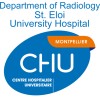
BilatEral Hypoglossal Nerve StimulaTion for TreatmEnt of ObstRuctive SLEEP Apnoea With and Without...
Obstructive Sleep ApneaThe objective of this study is to explore the safety and performance of the Genio™ system in adult obstructive sleep apnoea (OSA) patients with and without complete concentric collapse of the soft palate over a period of 4.5 months of treatment (i.e. 6 months post-surgery) measured by the AHI, at rest to determine if there is a difference in performance between the two populations.

3D Printer Modified CPAP Mask for Obstructive Sleep Apnea
Obstructive Sleep ApneaThis is a prospective pilot to investigate the effect of 3D printer customized CPAP masks on the comfort of patients with obstructive sleep apnea.

m-Rehab OSA : Impact of a Telerehabilitation Program Associated With CPAP on Severity Markers of...
Obstructive Sleep Apnea SyndromeObstructive sleep apnea syndrome (OSA) is a common condition associated with major repercussions such as excessive daytime sleepiness and impaired quality of life as well as metabolic and cardiovascular complications. Continuous positive airway pressure (CPAP) remains the treatment of choice but its effectiveness remains limited, especially in reducing cardio-metabolic risk. Interventions to modify the lifestyle are therefore recommended in the management of OSA. The emergence of information and communication technologies is an opportunity for patients to have tools that promote self-management and behavioral changes. The recent development of telerehabilitation (TR) is a promising approach that has only been the subject of pilot studies. In a randomized, controlled and multicenter study, we propose to test the hypothesis according to which the use of a mobile TR solution, associated with continuous positive airway pressure (CPAP), will allow obese patients to adopt behavioral modifications to improve markers of severity of OSA. The analysis of big data (data-mining) will allow a better understanding of the motivational obstacles and levers.

Effect of Liraglutide vs CPAP on Cardiometabolic Outcomes in Obstructive Sleep Apnea
Sleep ApneaObstructiveThis is an explorative, proof-of-concept study exploring the potential therapeutic role of a Liraglutide-based weight loss regimen versus standard CPAP or the combination of both on metabolic parameters, blood pressure, endothelial function, coronary artery calcification, vascular inflammation and apnea/hypopnea index in non-diabetic patients with moderate to severe obstructive sleep apnea

Metabolic Study of Women With Polycystic Ovary Syndrome and Sleep Apnea
Polycystic Ovary SyndromeObstructive Sleep ApneaThe purpose of this study is to look at the metabolic (use of energy) and hormonal features of sleep problems in women with polycystic ovary syndrome (PCOS).

AD816 Crossover Study
OSAObstructive Sleep ApneaThe VicTor Study is a randomized, double blind, placebo-controlled, 3-period, multiple-dose crossover study in participants with OSA.

A Cardiosleep Research Program on Obstructive Sleep Apnea, Blood Pressure Control and Maladaptive...
Hypertension,EssentialObstructive Sleep ApneaThe objective of this proposal is to evaluate whether mandibular advancement device (MAD) is non-inferior to continuous positive airway pressure (CPAP) in the treatment of obstructive sleep apnea (OSA) and blood pressure reduction. OSA and hypertension are highly prevalent disorders with profound impacts on health. Apart from improving quality of-life, an effective OSA treatment could improve cardiovascular risk partly through blood pressure reduction, particularly in patients with high cardiovascular risk in whom blood pressure control is often suboptimal. Although CPAP is useful, the high non-acceptance and non-adherence preclude its widespread use. East Asians have a restrictive craniofacial phenotype that predisposes them to OSA and the associated cardiovascular stress. CPAP, while considered the first-line therapy for OSA, has failed to improve cardiovascular outcomes in randomized trials till date because it is poorly tolerated. MADs are oral appliances that correct the restrictive craniofacial phenotype present in East Asians by protruding the lower jaw to reduce upper airway collapsibility. MADs are better tolerated than CPAP, and this may be an important determinant of the overall effectiveness in treating OSA, and thus ameliorating the downstream adverse health outcomes. We hypothesize that MADs are non-inferior to CPAP in treating OSA and reducing cardiovascular risk by blood pressure reduction in East Asians. We will recruit East Asian subjects with hypertension and high cardiovascular risk for polysomnography. Patients diagnosed with OSA (n=220) will be randomized to MAD or CPAP groups in a 1:1 ratio for a treatment duration of 6 months. The primary endpoint is the 24-hour mean blood pressure as determined by ambulatory monitoring. The secondary endpoints include sleep-time systolic BP, target blood pressure, cardiovascular biomarkers, and myocardial remodeling. Association between OSA and silent paroxysmal atrial fibrillation will also be determined. If MADs are shown to be effective, the next step is to evaluate our novel device- drug-eluting MAD that the team is developing.

Prospective Evaluation of a Palato-Pharyngeal Implant System (PPIS) Obstructive Sleep Apnea Syndrome...
SnoringObstructive Sleep ApneaProspective Evaluation of a Palato-Pharyngeal Implant System (PPIS) for the Treatment of Snoring and Obstructive Sleep Apnea Syndrome (OSAS): A Pilot Study.

Obstructive Sleep Apnea Master Protocol GPIF: A Study of Tirzepatide (LY3298176) in Participants...
Sleep ApneaObesityThe purpose of this study is to evaluate the effect and safety of tirzepatide in participants with obstructive sleep apnea and obesity who are both unwilling or unable to use Positive Airway Pressure (PAP) therapy in GPI1 and those who are and plan to stay on PAP therapy in GPI2.

Study Using Negative Pressure to Reduce Apnea
Sleep ApneaObstructive2 moreThe objective of this study is to determine the safety and effectiveness of the aerSleep® II device for treatment of moderate to severe Obstructive Sleep Apnea (OSA) over 24 weeks of home use in spontaneously breathing adult subjects who are intolerant of Continuous Positive Airway Pressure (CPAP) therapy.
